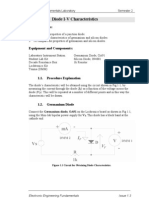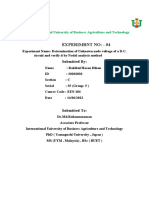100%(2)100% found this document useful (2 votes)
7K viewsLab Report - AC Circuits
This document provides instructions for a laboratory session on simple circuits. Students will use equipment like a circuit board, multimeter, signal generator and oscilloscope to build circuits with resistors, capacitors and inductors. A signal will be passed through each circuit to observe how the components affect the signal's behavior, phase relationships, reactance and Q factor. The method will be described for one of the experiments as the process is generally the same for all three.
Uploaded by
Yujin MatsutoyaCopyright
© Attribution Non-Commercial (BY-NC)
Available Formats
Download as ODT, PDF, TXT or read online on Scribd
100%(2)100% found this document useful (2 votes)
7K viewsLab Report - AC Circuits
This document provides instructions for a laboratory session on simple circuits. Students will use equipment like a circuit board, multimeter, signal generator and oscilloscope to build circuits with resistors, capacitors and inductors. A signal will be passed through each circuit to observe how the components affect the signal's behavior, phase relationships, reactance and Q factor. The method will be described for one of the experiments as the process is generally the same for all three.
Uploaded by
Yujin MatsutoyaCopyright
© Attribution Non-Commercial (BY-NC)
Available Formats
Download as ODT, PDF, TXT or read online on Scribd
You are on page 1/ 1
Introduction: In this laboratory session, we will be dealing with simple circuits formed of resistors, capacitors and inductors.
We will be passing AC signals from a signal generator through the circuit to monitor how the respective components affect the signals' behaviour. In particular we will be monitoring phase relationships, component reactance and the Q factor.
Equipment: Circuit Board Digital Multimeter x2 Shorting Links and Connecting Leads Signal Generator (EI810322) Oscilloscope (EI211384)
Method: As the method of all three experiments are generally the same, I will describe the process of only one of the experiments.
You might also like
- Electrical Devices Exp 1 - Determination of Characteristic Curve of A DiodeNo ratings yetElectrical Devices Exp 1 - Determination of Characteristic Curve of A Diode13 pages
- Verification of Kirchhoff's Voltage Law (KVL) and Kirchhoff's Current Law (KCL)100% (1)Verification of Kirchhoff's Voltage Law (KVL) and Kirchhoff's Current Law (KCL)3 pages
- Laboratory Experiment 4 Rectifiers and FiltersNo ratings yetLaboratory Experiment 4 Rectifiers and Filters16 pages
- Verification of Maximum Power Transfer TheoremNo ratings yetVerification of Maximum Power Transfer Theorem4 pages
- DC Lab Exp 1 (Familiarizing With The Basic DC Circuit Terms & Concepts. Introduction To Laboratory Equipment.) - ACSNo ratings yetDC Lab Exp 1 (Familiarizing With The Basic DC Circuit Terms & Concepts. Introduction To Laboratory Equipment.) - ACS8 pages
- Lab Answer Sheet - E6 CHARACTERISTICS OF BJT AMPLIFIER EEE410/EPO413No ratings yetLab Answer Sheet - E6 CHARACTERISTICS OF BJT AMPLIFIER EEE410/EPO41312 pages
- Experiment 1: BJT Fixed Bias Configuration: B C E CE C B ENo ratings yetExperiment 1: BJT Fixed Bias Configuration: B C E CE C B E4 pages
- Experiment #11 Maximum Power Transfer Theorem: ObjectivesNo ratings yetExperiment #11 Maximum Power Transfer Theorem: Objectives4 pages
- Measurement of Reactive Power of Star and Delta Connected Balanced Loads0% (1)Measurement of Reactive Power of Star and Delta Connected Balanced Loads3 pages
- Experiment No. 2: To Obtain V-I Characteristics of PN Junction Diode. Lab ObjectiveNo ratings yetExperiment No. 2: To Obtain V-I Characteristics of PN Junction Diode. Lab Objective5 pages
- DC Lab Exp 4 (Verification of - Y Conversion and Calculation of Equivalent Resistance.)No ratings yetDC Lab Exp 4 (Verification of - Y Conversion and Calculation of Equivalent Resistance.)7 pages
- Interpretation of Data and Result and Conclusion. Exp.6 - Resonance FrequencyNo ratings yetInterpretation of Data and Result and Conclusion. Exp.6 - Resonance Frequency1 page
- Experiment 5 - Internal Resistance of AmmeterNo ratings yetExperiment 5 - Internal Resistance of Ammeter3 pages
- North South University: Lab 5: Delta-Wye Conversion0% (1)North South University: Lab 5: Delta-Wye Conversion6 pages
- Electronic Devices and Circuits Lab - Full Wave Rectifier With and Without Filters - Notes - SboNo ratings yetElectronic Devices and Circuits Lab - Full Wave Rectifier With and Without Filters - Notes - Sbo6 pages
- DC LAB EXP 02 (Study of Series Circuit and Verification of Kirchoff's Voltage Law (KVL) )No ratings yetDC LAB EXP 02 (Study of Series Circuit and Verification of Kirchoff's Voltage Law (KVL) )7 pages
- Module 1 Measurement of Inductance and CapacitanceNo ratings yetModule 1 Measurement of Inductance and Capacitance15 pages
- Experiment 2-The Emitter-Follower Amplifier100% (1)Experiment 2-The Emitter-Follower Amplifier2 pages
- 3-Experiment - 3 - Verification of Thevenin's Theorem-10-03-2022No ratings yet3-Experiment - 3 - Verification of Thevenin's Theorem-10-03-20224 pages
- 1-Experiment - 1 - Verification of Mesh Current Analysis-24-02-2022No ratings yet1-Experiment - 1 - Verification of Mesh Current Analysis-24-02-20222 pages
- Ac Thevenin'S Theorem and Maximum Power Transfer: Laboratory Experiment #6No ratings yetAc Thevenin'S Theorem and Maximum Power Transfer: Laboratory Experiment #615 pages



























































